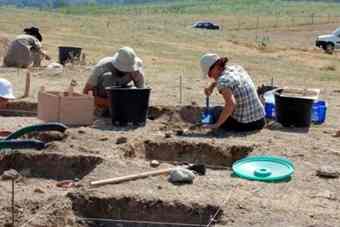New inscriptions have been unearthed during excavations at the ancient city of Pompeiopolis, in Taşköprü in the northern province of Kastamonu. Professor Christian Marek, who has been examining the inscriptions, said they were probably referred to festivals from the Roman era.
 Marek said that according to the inscriptions, Roman emperors participated in these festivals, most of which were religious. Marek said several competitions, shows and plays were held as part of these festivals, which are thought to have been started by Roman Emperor Alexander Severus. "There were… competitions and music shows, as well as tragedy and comedy shows in the festivals. These festivals were organized every three to five years and hosted significant people of the period," he added.
Marek said that according to the inscriptions, Roman emperors participated in these festivals, most of which were religious. Marek said several competitions, shows and plays were held as part of these festivals, which are thought to have been started by Roman Emperor Alexander Severus. "There were… competitions and music shows, as well as tragedy and comedy shows in the festivals. These festivals were organized every three to five years and hosted significant people of the period," he added.
Professor Latife Summerer, a lecturer from Munich University who has been leading the excavations for five years, said that information on the inscriptions was important and more would be uncovered in excavations still to be held in the ancient city.
According to historical records, after winning the battle against Mithridates Pontius Pilate and his army in the northern valley of Gökirmak in 64 B.C., the Romans settled in this region. The Roman commander Pompeious built a city on Zimbilli Hill and called the city Pompeiopolis.
The ancient city of Pompeiopolis was discovered by Pascal T. Fourcade, French consul from 1802 to 1812. It is claimed by American and European archaeologists that the ancient city is wealthier and bigger than the ancient city of Ephesus in İzmir.
As the archaeological excavation of Pompeiopolis continues, a town museum or an archaeological museum must be built in Taşköprü to protect and exhibit artifacts. As more and more historical artifacts are discovered, the ancient city of Pompeiopolis will promote the Black Sea to the world. If the necessary investments in tourist infrastructure are made, Pompeiopolis, just like Ephesus and Zeugma, will become the symbol of the Black Sea within a short period of time and its name will heralded among the most important historical tourism sites in the whole world.
Source: Hurriyet [August 23, 2010]





